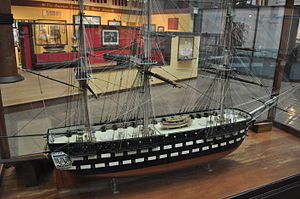
USS New Hampshire was a 2,633-ton ship originally designed to be the 74-gun ship of the line Alabama, but she remained on the stocks for nearly 40 years, well into the age of steam, before being renamed and launched as a storeship and depot ship during the American Civil War. She was later renamed to USS Granite State.

The first USS Sabine was a sailing frigate built by the United States Navy in 1855. The ship was among the first ships to see action in the American Civil War. In 1862, a large portion of the USS Monitor crew were volunteers from the Sabine.

USS Santee was a wooden-hulled, three-masted sailing frigate of the United States Navy. She was the first U.S. Navy ship to be so named and was one of its last sailing frigates in service. She was acquired by the Union Navy at the start of the American Civil War, outfitted with heavy guns and a crew of 480, and was assigned as a gunboat in the Union blockade of the Confederate States. She later became a training ship then a barracks ship for the U.S. Naval Academy.

The first USS Pawnee was a sloop-of-war in the United States Navy during the American Civil War. She was named for the Pawnee Indian tribe.
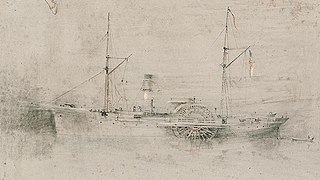
USSKeystone State was a wooden sidewheel steamer that served in the Union Navy during the American Civil War. She was a fast ship for her day and was used effectively to blockade Confederate ports on the Atlantic coast. She participated in the capture or destruction of 17 blockade runners. In addition to her military service, Keystone State had a lengthy commercial career before the war. Renamed San Francisco, she also sailed commercially after the war. The ship was built in 1853 and scrapped in 1874.

USS St. Lawrence was a frigate in the United States Navy that saw service during the mid-19th century, including the American Civil War. She was based on the same plans as USS Brandywine.
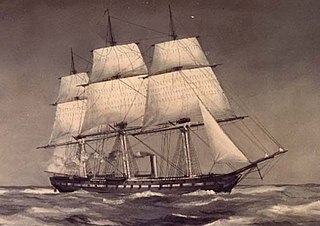
USS Wabash was a steam screw frigate of the United States Navy that served during the American Civil War. She was based on the same plans as Colorado. Post-war she continued to serve her country in European operations and eventually served as a barracks ship in Boston, Massachusetts, and was sold in 1912.
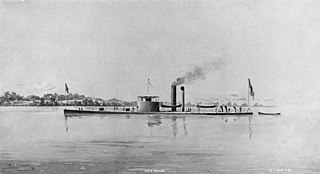
The first Passaic was a single turreted, coastal monitor purchased by the United States Navy for service during the American Civil War.
The first USS Mohican was a steam sloop-of-war in the United States Navy during the American Civil War. She was named for the Mohican tribe and was the first ship of her class.

|} The first USS Tuscarora was a Mohican-class sloop of war in the United States Navy during the American Civil War. Tuscarora was laid down on 27 June 1861 at Philadelphia, Pennsylvania, by Merrick & Sons; launched on 24 August 1861; sponsored by Miss Margaret Lardner; and commissioned on 5 December 1861, Commander Tunis A. M. Craven in command.

The first USS Seminole was a steam sloop-of-war in the United States Navy during the American Civil War.

The first USS Pocahontas, a screw steamer built at Medford, Massachusetts in 1852 as City of Boston, and purchased by the Navy at Boston, Massachusetts on 20 March 1855, was the first United States Navy ship to be named for Pocahontas, the Algonquian wife of Virginia colonist John Rolfe. She was originally commissioned as USS Despatch – the second U.S. Navy ship of that name – on 17 January 1856, with Lieutenant T. M. Crossan in command, and was recommissioned and renamed in 1860, seeing action in the American Civil War. As Pocahontas, one of her junior officers was Alfred Thayer Mahan, who would later achieve international fame as a military writer and theorist of naval power.

USS James Adger was a sidewheel steamer in the Union Navy during the American Civil War. She retained her former name.
The second USS Kensington was a steamship in the United States Navy.

USS Unadilla was a Unadilla-class gunboat built for service with the United States Navy during the American Civil War. She was the lead ship in her class.

USS Vanderbilt was a heavy (3,360-ton) passenger steamship obtained by the Union Navy during the second year of the American Civil War and utilized as a cruiser.
USS Whitehall was a steamer acquired by the Union Navy during the American Civil War. She was assigned blockade duty; however, her condition was not always considered seaworthy, and she was plagued with condition problems.
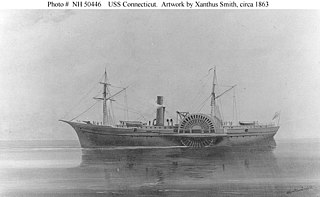
USS Connecticut was a large steamer acquired by the Union Navy during the American Civil War. Her primary task was to prevent ships from penetrating the Union blockade of Southern ports.

USS Lodona was a British steamship of the same name captured by the Union Navy during the American Civil War. She had been built in England for shipowner Zachariah Pearson and attempted to break the United States' blockade of Confederate ports. USS Lodona was used by the Navy to patrol waters off those ports. After the war she returned to commercial ownership.
USS Gemsbok was a bark acquired by the Union Navy during the American Civil War. She was used by the Navy as a gunboat, but, later in the war, she was also used as a collier and as a storeship.
